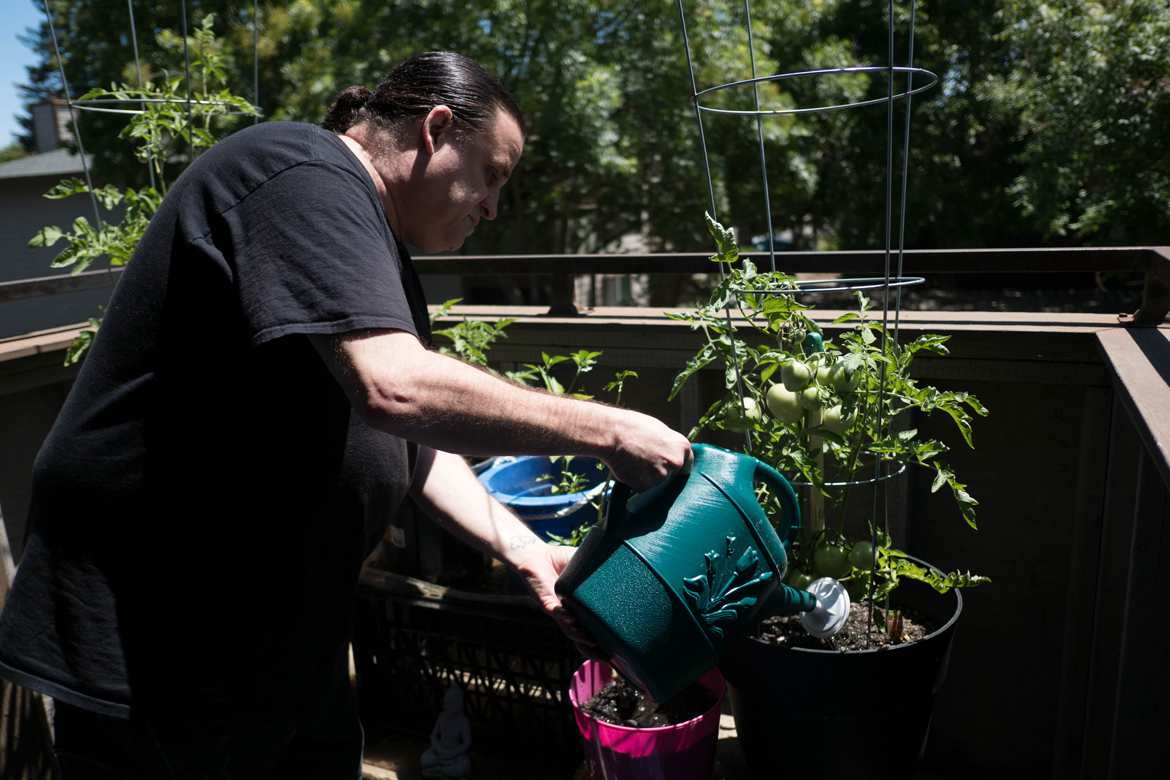Listen here to Pauline Bartolone’s radio version of this story, which first ran on Capital Public Radio.
Can’t see the audio player? Click here to download.
During the five years Tony Price roamed the streets and dozed in doorways, the emergency rooms of Sacramento’s hospitals were a regular place for him to sleep off a hard day’s drinking.
“A lot of times I would pass out, and then I’d wake up in the hospital,” said Price, 50.
About two or three times a month, he would show up at a local emergency department. Sometimes doctors hydrated him with intravenous fluids and sent him on his way. Other times, they kept him a night or two.
“I’m kind of ashamed to say this, but sometimes it was just cold, and I [got] drunk,” Price said. “I just want[ed] to be warm and safe.”
Hospitals in Sacramento, Calif., and around the country are taking steps to help homeless people find housing. Doing so, they say, will limit unnecessary ER visits and reduce wasteful health care spending. It also helps nonprofits such as San Francisco-based Dignity Health, Orlando-based Florida Hospital and Providence Health & Services in Portland, Ore., meet their community service obligations in exchange for tax breaks.
Dignity Health’s “Housing With Dignity” program in Sacramento got Price into an apartment, paid his rent for four months and set him up with a social worker who helped him become eligible for permanent housing.
Without that help, “I definitely would have been dead by now,” Price said.
A growing number of hospitals nationwide have invested in housing programs in recent years, from Florida to Chicago and farther west.
The Corporation for Supportive Housing (CSH), a national lender and promoter of housing development for homeless people, says hospitals put $75 million to $100 million into projects it has embraced over the past several years.
In Oregon, five hospital systems invested in a $21.5 million project last year to build nearly 400 units for homeless people.
In Northern California, Sutter Health earlier this year launched an ambitious $30 million campaign to end homelessness in Sacramento and two adjacent counties.
“There’s pretty good evidence that it’s more cost-effective to provide housing with supports than have these people live on the streets and just cycle in and out of emergency rooms and in-patient stays,” said Sarah Hunter, a researcher at the Santa Monica-based think tank Rand Corp.
A widely cited 2002 study showed that providing housing and supportive services to more than 4,600 mentally ill homeless people in New York City dramatically reduced their stays in hospitals, shelters and correctional facilities — though the cost of the housing offset the savings.
A 2009 analysis of supportive housing in Los Angeles County showed that people with stable housing cost taxpayers 79 percent less than their homeless counterparts, and most of the savings were in health care.
However, a recent Health Affairs analysis noted that it’s hard to draw definitive conclusions about the cost effectiveness of such programs because they are usually small, the study methods variable and the data not always of the highest quality.
Cost savings are not the only benefit of housing homeless people. It’s also a way for nonprofit hospitals to “check a box” that exempts them from taxes, said Anthony Galace, director of health policy at the Berkeley, Calif.-based Greenlining Institute, which advocates for racial and economic justice.
And, “from a PR standpoint, it endears them to homelessness advocates,” Galace said.
But he and other advocates say that recent efforts of health systems such as Sutter and Dignity will not make a significant dent in the homelessness problem on their own, even if they do make a difference for one person at a time. To tackle the problem systemically, “we have to have enough [investments] to meet the size of the problem,” said Joan Burke, director of advocacy for Loaves and Fishes, Sacramento’s largest homeless shelter.
California Gov. Jerry Brown recently signed a new state law expected to generate $200 million to $300 million a year for affordable housing from a real estate transaction fee. Housing advocates said it’s too soon to know if the new money can help contain homelessness.

Price keeps a small garden on his patio and shares the produce he grows. (Andrew Nixon/Capital Public Radio)
The Housing With Dignity program that got Tony Price off the streets is young and tiny. When it started in 2014, it served just five clients at a time on a budget of $150,000 a year. Now it houses 12 formerly homeless people at any given time, with financial assistance from the insurer Health Net.
That’s a drop in the bucket compared with the estimated 3,665 Sacramento residents who are homeless, according to the latest data. But Dignity says it is not aiming to end homelessness. Rather, the program is designed to help ensure that the homeless patients it does take in get follow-up care after they’re discharged, said Ashley Brand, Dignity’s director of community health and outreach.
“Our hope is [that] dependency on the hospital services will be reduced,” she said.
Sutter Health executives say that after years of investing in programs that serve smaller groups of homeless people, they wanted to be more ambitious.
Sutter committed to raising $20 million from public and private investors to help pay for its anti-homelessness project in the region. It’s also throwing in $10 million of its own money, in part to satisfy the community benefit requirement that allows it to receive tax breaks as a nonprofit.
“We can continue to put dollars in again for programs that serve 200 people,” said Keri Thomas, vice president of external affairs for Sutter Health/Sacramento Valley Area. But there would always be 200 more homeless people the next year and the year after that, unless the hospital system made a bolder push to prevent people from ending up on the streets, she said.
So far, Sutter has matched investments by local governments to buy housing, pay rents and provide social services for homeless people.
Tony’s Next Phase
It wasn’t until 2015, after Price tried to commit suicide and spent a week recovering at Dignity Hospital, that things began to turn around for him.
Because he had been in the hospital so frequently, he qualified for the services offered by Housing With Dignity. It paid for a one-bedroom apartment in Sacramento’s sprawling North Highlands neighborhood and assigned him a social worker, Chris Grabe, who drove him to medical appointments.
Grabe later moved Price to a federally funded permanent housing program, which pays his rent of $806 a month and enables Grabe to continue checking in on him.
Price has been off the streets for nearly 2½ years, and he’s been to the hospital only once since January.
But the adjustment wasn’t easy. He had lived eight months in his first apartment before he quit drinking.
“I had one scare here where I was so drunk, I was outside yelling at people that I was going to shoot somebody,” Price recalled. “I completely trashed my apartment and I got arrested in my shorts.”
Grabe has stuck with him through the rough spots. As part of its “Housing First” philosophy, Dignity Health will lodge the most frequent users of its hospitals, even if they have a substance abuse problem or a criminal record.
Tony still struggles with anxiety, but having housing has put him on the path to sobriety and stability. He now gardens, and he recently volunteered at a church and as a leader of an Alcoholics Anonymous group.
“Out there, you have to think about yourself,” he said of his life on the streets. Now, “I don’t need to be in survival mode.”
This story was produced by Kaiser Health News, which publishes California Healthline, an editorially independent service of the California Health Care Foundation.









